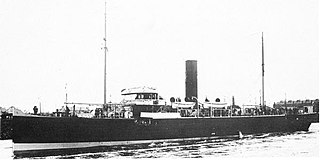
Q-ships, also known as Q-boats, decoy vessels, special service ships, or mystery ships, were heavily armed merchant ships with concealed weaponry, designed to lure submarines into making surface attacks. This gave Q-ships the chance to open fire and sink them. The use of Q-ships contributed to the abandonment of cruiser rules restricting attacks on unarmed merchant ships and to the shift to unrestricted submarine warfare in the 20th century.

ARA Santa Fe was an Argentine Balao-class submarine that was lost during the Falklands War. Built by the US during the Second World War, the ship operated in the United States Navy as USS Catfish (SS-339) until 1971 when she was transferred to the Argentine Navy. She served until 1982 when she was captured by the British at South Georgia after being seriously damaged and subsequently sank along a pier, with just her sail visible above the waterline. The submarine was raised, towed out of the bay and scuttled in deep waters in 1985.

HMS Sidon was a submarine of the Royal Navy, launched in September 1944, one of the third group of S class built by Cammell Laird & Co Limited, Birkenhead, named after the naval bombardment of Sidon in 1840. An explosion caused by a faulty torpedo sank her in Portland Harbour with the loss of 13 lives.

HMS Thetis (N25) was a Group 1 T-class submarine of the Royal Navy which sank during sea trials in Liverpool Bay, North Wales on 1 June 1939. After being salvaged and repaired, the boat was recommissioned as HMS Thunderbolt in 1940. It served during the Second World War until being lost with all hands in the Mediterranean on 14 March 1943.

Liugong Island is a small island located on the northeastern edge of Shandong Peninsula, China at the mouth of Weihai Bay. It is known as the "birthplace of China's first modern navy" and is also the site of its defeat in the First Sino-Japanese War.

HMS Graph was a German Type VIIC U-boat that the British Royal Navy captured during World War II. Commissioned as U-570 in Nazi Germany's Kriegsmarine in mid-1941, she was attacked and captured on her first patrol.
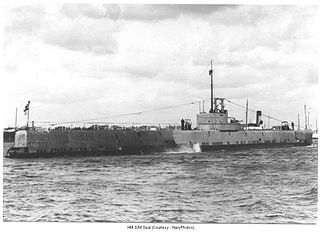
HMS Seal was one of six Grampus-class mine-laying submarines of the Royal Navy. She served in the Second World War and was captured by the Kriegsmarine and taken into German service as UB, one of several captured subs. She was the only submarine the Germans captured at sea during World War II. Her capture allowed the Germans to correct a critical fault in their U-boat torpedoes.

HMS Truculent was a British submarine of the third group of the T-class. She was built as P315 by Vickers Armstrong, Barrow, and launched on 12 September 1942. She sank nine enemy vessels.

A United States Navy diver refers to a service personnel that may be a restricted fleet line officer, civil engineer corps (CEC) officer, Medical Corps officer, or an enlisted who is qualified in underwater diving and salvage. Navy divers serve with fleet diving detachments and in research and development. Some of the mission areas of the Navy diver include: marine salvage, harbor clearance, underwater ship husbandry and repair, submarine rescue, saturation diving, experimental diving, underwater construction and welding, as well as serving as technical experts to the Navy SEALs, Marine Corps, and Navy EOD diving commands.

The Holland 602 type submarine, also known as the H-class submarine, was one of the most numerous submarines of World War I. The type was designed by the Electric Boat Co. of the United States, but most of the boats were built abroad: in Canada by the subsidiary of the British Vickers company and in British shipyards.

The Parthian-class submarine or P class was a class of six submarines built for the Royal Navy in the late 1920s. They were designed as long-range patrol submarines for the Far East. These boats were almost identical to the Odin class, the only difference being a different bow shape.
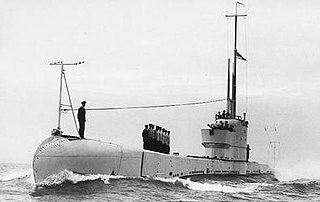
HMS Poseidon (P99) was a Parthian-class submarine designed and built by Vickers Shipbuilding and Engineering in Barrow-in-Furness for the Royal Navy, launched on 22 August 1929. She spent most of her short career assigned to the Yellow Sea region, based at the Royal Navy's Weihai naval base in mainland China. In 1931, the submarine sank after a collision with the steamship Yuta north of Weihai. The submarine was later secretly salvaged by the Chinese in 1972.

HMS Sickle was a third-batch S-class submarine built for the Royal Navy during World War II. Completed in 1942, she made her initial war patrol off the Norwegian coast. Sickle then sailed to Gibraltar, from where she conducted one patrol, then to Algiers, French North Africa. From 10 May to 10 October, the boat patrolled the Gulf of Genoa five times and sank a German submarine as well as three minesweepers and an escort ship. She then moved to Beirut, French Lebanon, and conducted two patrols in the Aegean Sea, sinking three caïques and a merchant ship, in addition to landing resistance operatives in Greece.

HMS Tiptoe was a British submarine of the third group of the T class. She was built by Vickers Armstrong, Barrow, and launched on 25 February 1944. She was one of two submarines named by Winston Churchill, and so far has been the only ship of the Royal Navy to be named Tiptoe. In 1955 she was involved in a collision with a coastal steamer whilst in Tromsø harbour. She was involved in escape trials off Malta in 1962, and the commanding officer was reprimanded in 1964 following an incident in the Firth of Clyde where she was run aground, and again in 1965 when she collided with HMS Yarmouth. Although originally named for the ability to sneak up on someone undetected, she maintained several links with ballet, including the Royal Ballet and ballet dancer Moira Shearer. She was scrapped at Portsmouth in 1975, while her anchor is on display in Blyth, Northumberland.

Morning Departure is a 1950 British naval drama film about life aboard a sunken submarine, directed by Roy Ward Baker, and starring John Mills and Richard Attenborough. It is based on a stage play of the same name by Kenneth Woollard, which had also been shown as a live TV play by the BBC both in 1946 and 1948. It was the feature film debut of Michael Caine.
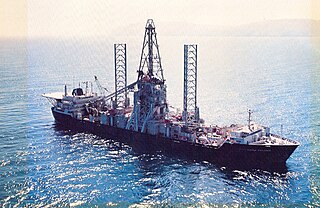
Project Azorian was a U.S. Central Intelligence Agency (CIA) project to recover the sunken Soviet submarine K-129 from the Pacific Ocean floor in 1974, using the purpose-built ship Hughes Glomar Explorer. The 1968 sinking of K-129 occurred approximately 1,600 miles (2,600 km) northwest of Hawaii. Project Azorian was one of the most complex, expensive, and secretive intelligence operations of the Cold War at a cost of about $800 million, or $4 billion today.
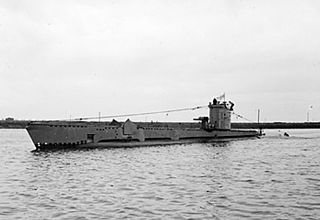
During the action of 9 February 1945, HMS Venturer, a V-class submarine of the Royal Navy, which was patrolling the waters around Fedje Island, off the Norwegian coast in the North Sea, attacked and sank the German U-boat German submarine U-864.
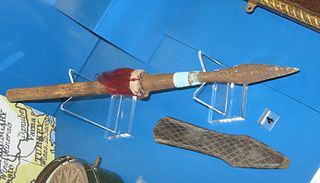
The Irene incident of 1927 was a significant event of the British anti-piracy operations in China during the first half of the 20th century. In an attempt to surprise the pirates of Bias Bay, about sixty miles from Hong Kong, Royal Navy submarines attacked the merchant ship SS Irene, of the China Merchants Steam Navigation Company, which had been taken over by the pirates on the night of 19 October. The British were successful in thwarting the hijacking though they sank the ship.

HMS J6 was a First World War J-class submarine built for the Royal Navy by HM Dockyard at Devonport in Plymouth. Commissioned in 1916 she was sunk in a friendly fire incident by the Q-ship Cymric in October 1918.



















